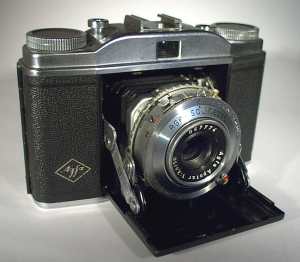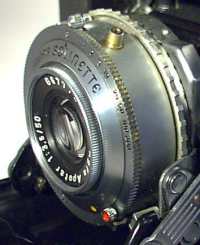|
Click here for complete Site Map
This is an Agfa Solinette II dating from about 1955. Its a 35mm folding camera which takes standard cassettes giving the usual 24x36mm pictures. The Agfa Solinette II is a bit of an oddity as 35mm folding cameras had by this time been largely replaced by fixed body cameras such as the Agfa Silette. The Solinette is more like a cross between a Silette and Agfa Isolette II. Alternatively it could be described as a Silette with bellows.
The Solinette II was a development of the original Solinette which was largely the same camera. There was some variation in lenses/shutters across the cameras - but in conclusion the Solinette was short lived range of cameras from the middle of the 1950's.
A Solinette II of this configuration would have cost in 1955, (pounds, shillings and pence) £24 12s 7d including purchase tax. Value today is more like £20-£40.
|

|
|
Specifications
|
|
Lens Type
|
3 element (coated) Apotar
|
|
Focal Length
|
50mm
|
|
Maximum Aperture
|
F3.5
|
|
Film Type
|
35mm standard cassette
|
|
Picture Size
|
24x36mm
|
|
Shutter
|
8 speed Prontor-SV + B
|
|
Flash Sync
|
X and M
|
|
This picture was taken with a Epson PhotoPC 650 digital camera.
A review of the Solinette II appeared in the 1955 edition of "The British Journal Photographic Almanac", where the following was said of it:
The interior of the camera body is finished to high standard and indeed the whole appearance of the camera indicates that it is an instrument of high quality.
|

|
This closeup of the lens/shutter shows the high quality of finish mentioned above. It also shows the ribbed focus ring which moves the whole lens/shutter assembly back and forth for focussing. This arrangement provides a better quality picture than just moving the front element of the lens which is the normal method of operation on many small cameras of this period.
|
|
This picture was taken with a Epson PhotoPC 650 digital camera.
|
|
Some notes on using the Solinette II
There doesn't seem to be much info around on the Solinette II and as we sometimes get asked questions about it, here are some general notes which hopefully will be of some use.
The Solinette II actually is a very conventional camera - and holds no real surprises for anybody used to older style mechanical cameras.
(all descriptions assume looking at back of camera - as would if holding it to take a picture).
Conveniently the Solinette II takes ordinary 35mm film - so you have the widest possible choice of film types. The back opens by pulling down on a little catch on the side opposite the hinge for the back. Inside on the left will be where the 35mm cassette goes and on the right - the takeup spool where the film leader goes.
Winding is via the knob on the right (with the counter clockwise arrow) and if you do this with the back open you can seen the film takeup spool rotate (and you should also hear a clicking noise).
There is no need to set the film speed as there is no built in light meter (Click HERE for more info on this subject). However you do need to set the shutter/speed and aperture manually.
Shutter speed is on a ring marked B,1,2,5,10,25,50,100,300 etc. In each case these are fractions of a seconds - apart from 'B' which just keeps the shutter open as long as the button is pressed. (yours might have a slightly different range of numbers)
Unlike more modern cameras - winding the film on doesn't cock the shutter (cocking the shutter is tensioning the spring inside so it fires very rapidly when you push the button). The shutter is cocked by pulling the small lever at the front of the shutter (just behind the speed select ring) from left to right. It should lock in position.
Like modern cameras - to actually fire the shutter - you use the button to the right of the viewfinder. The camera is fitted with a double exposure protection - to ensure you wind the film on between taking each picture. With no film loaded - the shutter release button won't work as the camera cannot detect the film moving properly. Don't worry - just load a film and all will be well.
Aperture is on the scale 3.5 - 22. The smaller the number - the more light that gets let in.
To use properly you need a separate light meter - but colour print film is very forgiving so an aperture of 11 with a shutter speed of 100 will give okay results outside in daylight (using ASA100 or 200 speed film)
Maybe at some time in the future we'll have a guide to basic manual camera technique using shutter speeds and aperture controls. However as this info is universal - any decent camera book (and probably dozens of other websites) should fill in most of the detail.
Got a question or can't find the info you are looking for? Click HERE to contact us.
Click here for the Agfa shelf
Click here for complete Site Map
|


